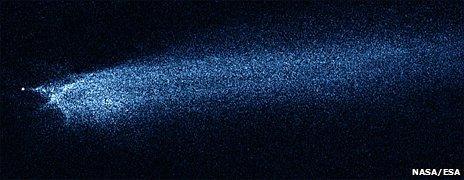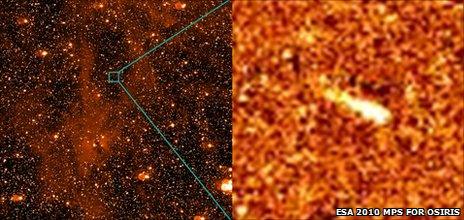Asteroid collision makes quite a picture
- Published

Hubble's pictures reveal an unusual "X-shape" to the debris field
The dusty wreckage thrown out in the explosive collision of two asteroids has been pictured by spacecraft.
The debris stretches for hundreds of thousands of kilometres.
US and European scientists tell the journal Nature that a remnant rock about 120m in size sits at the head of this shattered stream of material.
Their investigations using the powerful imaging equipment on the Hubble telescope and the Rosetta probe suggest the pile-up occurred in early 2009.
Colin Snodgrass from the Max Planck Institute for Solar System Research, Katlenburg-Lindau, Germany, worked on the Rosetta data, external.
He said the event offered a unique observing opportunity for researchers studying the Solar System.
"If you look at the literature on 'recent' asteroid collisions, they tend to talk about things occurring in the past million years or so - that's recent on geological timescales. But on the timescales involved in this event, we're really catching it in the moment of happening," he told BBC News.
The collision occurred beyond the orbit of Mars, hundreds of millions of km from Earth.
Unified conclusions
Two groups working independently studied the impact, and their findings are in strong agreement.
Initially, they thought they were looking at a comet which produces a characteristic trail of material as the ices that make up most of its body boil off in sunlight.
But when the researchers looked closer at their subject, they discovered some very un-comet-like features. The object, dubbed P/2010 A2, did not have the shroud, or coma, of gases enveloping its main body; nor was it moving in a direction expected of a comet in that part of the Solar System.
It was down to Hubble and Rosetta to reveal the object's true nature - a large rock followed by a wide band of debris blasted off its surface by the impact of a much smaller object that was itself most probably vaporised in the impact.
The two spacecraft brought different perspectives to the research given their widely separated viewing positions.
Hubble is sited in orbit around the Earth and can see some exceptionally fine detail; Rosetta, on the other hand, is positioned between Mars and Jupiter and can see aspects of the object's geometry that are beyond home-based observatories, revealing the debris stream's overall shape and angle.
Modelling the patterns in the dusty wreckage leads the scientists to the conclusion that the collision probably occurred sometime in February or March 2009.

Rosetta reveals the debris stream's overall shape and angle.
David Jewitt, of the University of California, Los Angeles, led the Hubble group, external.
He said the research provided new insights into how asteroids behaved when they smashed into each other, and how the fall-out from these impacts contributed to the dust that pervades the Solar System.
"These observations are important because we need to know where the dust in the Solar System comes from, and how much of it comes from colliding asteroids as opposed to 'outgassing' comets," he explained.
"We can also apply this knowledge to the dusty debris discs around other stars, because these are thought to be produced by collisions between unseen bodies in the discs. Knowing how the dust was produced will yield clues about those invisible bodies."
Dr Jewitt said the smaller impactor was probably about three to five metres wide, and he calculated the pair likely collided at high speed, at about 18,000km/h.
This encounter was as powerful as the detonation of a small atomic bomb, the UCLA scientist noted.
The pressure of sunlight is now pushing the debris away from the remnant rock. If the material in this tail were brought together, it would make a ball 20m wide, Dr Jewitt suggested.
- Published4 October 2010
- Published10 July 2010
- Published6 July 2010
- Published28 April 2010